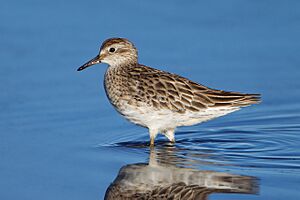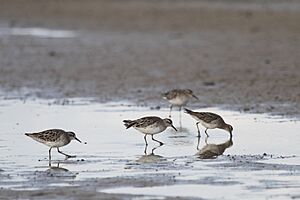Sharp-tailed sandpiper facts for kids
Quick facts for kids Sharp-tailed sandpiper |
|
|---|---|
 |
|
 |
|
| Conservation status | |
| Scientific classification | |
 |
The sharp-tailed sandpiper (Calidris acuminata) is a small bird that travels long distances. It's a type of wader or shorebird. These birds spend their summers (June to August) in Siberia, where they have their babies. Then, they fly all the way to Australia for the winter (September to March).
Contents
What's in a Name?
The name Calidris comes from an old Greek word. It was used by Aristotle for grey birds found near water. The second part, acuminata, is Latin. It means 'sharp' or 'pointed'. This might refer to the bird's sharp-looking feathers.
What Does a Sharp-Tailed Sandpiper Look Like?
This sandpiper is a small to medium-sized wader. It has a round body and a flat back. Its tail area looks a bit long. The top of its body is mottled chestnut-brown. Its feathers have dark centers, making them look sharp. It has a chestnut-colored cap on its head. A brown stripe goes through each eye.
Its bill is dark grey to black and straight. Its legs are olive-green or yellow. The underside of the bird is white or pale. The chest and sides of the belly have mottled patterns. The bird's colors are brighter during summer breeding. They become duller in winter. Young birds are brighter than adults in winter. They have sharper feathers and bright chestnut crowns. These crowns stand out against their white neck stripes. Their chests are also a bright, buffy color.
Another bird, the pectoral sandpiper, looks similar. Sharp-tailed sandpipers breed in the same area in Asia. You can tell them apart by their chest patterns. The sharp-tailed sandpiper also has a stronger eyebrow stripe. Its crown is more chestnut-colored. It looks a bit like the long-toed stint too. But the sharp-tailed sandpiper is much bigger.
How Big Are These Birds?
- Size: About 22 cm (8.7 inches) long
- Weight: 39–114 g (1.4–4 ounces)
- Wingspan: 36–43 cm (14–17 inches) wide
Where Do Sharp-Tailed Sandpipers Live and Travel?
Sharp-tailed sandpipers are strong migrators. They only breed in eastern Siberia. This area stretches from the Taymyr Peninsula to Chaunskaya Bay. Their migration journey is quite complex. Adult birds leave Siberia in July. Young birds leave in August. They all fly south. Most of them spend winter in Australasia.
They use two main routes. Most adults fly south in groups of less than 1000 birds. They fly east of Lake Baikal. Then they head to the Pacific coast of Russia. They also go to the Yellow Sea coasts of China and Korea. From there, most fly straight to Micronesia and New Guinea. This happens in late August. They leave these places when the wet season starts. Then they fly to northwest Australia in mid-September. They move towards southeast Australia. Their numbers are highest there from December to February.
The other route goes east. Most young birds and some adults use this path. They fly into Alaska across the Bering Strait. They stay there from mid-August to late October. This is to eat a lot and get fat. After that, they likely fly non-stop across the Pacific Ocean. This flight is over 10,000 km (6,200 miles) long. It takes them to Australia and New Zealand. Some birds continue south along the Pacific coast of North America. They reach Washington and sometimes California. A very few might even go to Latin America.
These birds are rarely seen in western Europe. Records show them in 11 different countries. Most sightings are in the United Kingdom. This happens between August and October. They have also been seen in the Middle East and Central Asia.
What Kind of Places Do They Like to Live In?
In Siberia, their breeding areas are mostly tundra. This land has peat-hummocks and lichen. When they are migrating, they like muddy edges of shallow wetlands. These wetlands can have fresh or slightly salty water. They prefer areas with grass, sedges, or low plants. This includes swamps, lakes, and pools near coasts. They also use waterholes, dams, and saltpans inland.
In Alaska, they seem to like moist grassy meadows near the coast. They also use muddy riverbanks that are exposed at low tide. In Australia, they are mostly found around wetlands. They prefer freshwater wetlands inland with grassy edges. When these temporary wetlands dry up, they move to coastal mudflats. They also use salt marshes and salty lagoons. Sometimes they are seen in wet fields with short grass. Other places they have been seen in Australia include sewage farms, flooded fields, and mangroves. They can even be found on rocky shores and beaches.
How Do Sharp-Tailed Sandpipers Behave?
Not much is known about the specific behavior of the sharp-tailed sandpiper. However, their actions and body structure are very similar to the pectoral sandpiper.
Life Cycle and Reproduction
Sharp-tailed sandpipers breed from June to August. This is during the short Siberian summer. They make shallow, hollow nests. These nests are lined with leaves and grass. They hide their nests on the ground. It is hard to see them because they blend in with the surroundings. Usually, they lay four eggs. The female bird takes care of the eggs. She also raises the chicks. During breeding, their feathers become more colorful. Their chest feathers get more chestnut color. Their chevron-shaped markings become clearer.
How Do They Find Food?
Sharp-tailed sandpipers look for food at the edge of wetlands. They also forage on muddy areas exposed by tides. This can be on sand or bare wet mud. They also feed in shallow water. Sometimes they look for food among wet grass or sedges. After it rains, they can be found in short grassy fields. These fields can be far from water. At low tide, they are on the muddy areas near the sea. When the tide comes in, they move inland to freshwater wetlands.
Sometimes they forage on dry or wet mats of algae. They also look among rotting seaweed on beaches. They can be found at the edges of stony wetlands and exposed reefs. They pick up food by sight. Sometimes they probe the mud with their bills. They mainly eat aquatic insects. They also eat molluscs, crustaceans, and worms. Occasionally, they eat seeds and other small invertebrates.
Why Are Sharp-Tailed Sandpipers Vulnerable?
The sharp-tailed sandpiper is currently listed as vulnerable. This means its population is decreasing. The IUCN Red List estimated 60,000 to 120,000 adult birds in 2021.
The biggest threats to these birds are losing their homes. The places they stop during migration are shrinking. This happens when land is used for aquaculture (raising fish or shellfish). Or when human activities damage the land. In Australia, wetlands are cleared, flooded, or filled in. This reduces places for them to find food and rest. This makes it harder for them to get enough energy. They need this energy to fly back to Siberia.
Their homes are also damaged in other ways. Plants along rivers are lost. Invasive species (plants or animals that don't belong) move in. Water pollution is a problem. Human actions also change how water flows.
Sharp-tailed sandpipers are also bothered by people. Growing towns and fun activities disturb them. This affects their breeding and feeding habits. More birds are also dying from hunting. They are hit by vehicles or aircraft. Predators like foxes and cats also hunt them.



